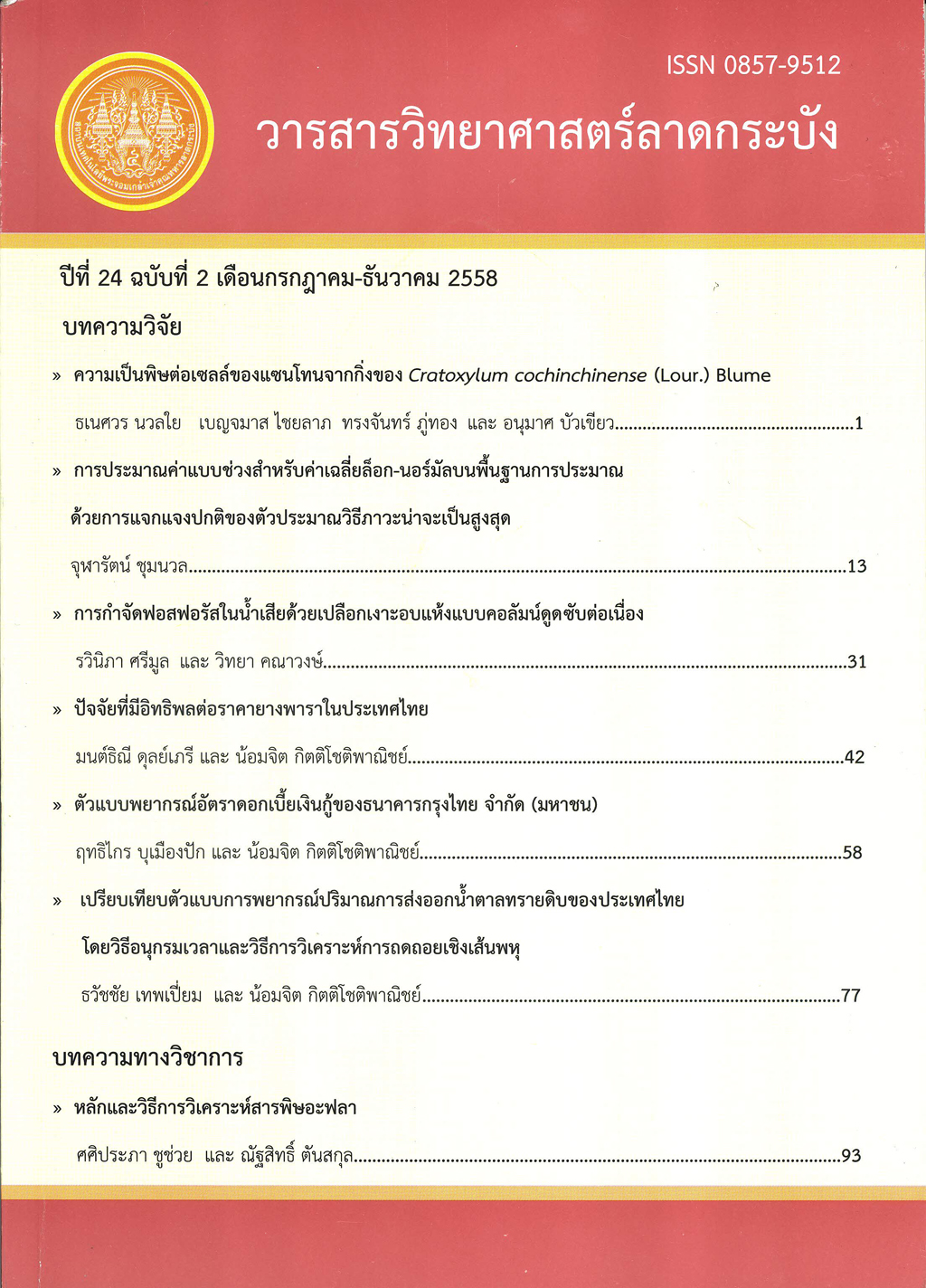การกำจัดฟอสฟอรัสในน้ำเสียด้วยเปลือกเงาะอบแห้งแบบคอลัมน์ดูดซับต่อเนื่อง
Main Article Content
Abstract
บทคัดย่อ
งานวิจัยนี้มีวัตถุประสงค์เพื่อศึกษาการดูดซับฟอสฟอรัสในน้ำเสียโดยใช้เปลือกเงาะอบแห้งโดยให้น้ำเสียไหลผ่านคอลัมน์อย่างต่อเนื่อง ศึกษาปัจจัยต่างๆ ได้แก่ อัตราการไหลของสารละลาย ความสูงของตัวดูดซับที่บรรจุในคอลัมน์ และความเข้มข้นเริ่มต้นของสารละลาย พบว่า เมื่ออัตราการไหลและความเข้มข้นของสารละลายฟอสฟอรัสลดลง รวมทั้งเพิ่มความสูงของตัวดูดซับในคอลัมน์ เวลาเบรคทรูเพิ่มขึ้น ทำให้ตัวดูดซับมีเวลาสัมผัสกับสารได้นานกว่า การดูดซับที่ความสูงของตัวดูดซับในคอลัมน์เท่ากับ 20 เซนติเมตร เส้นผ่าศูนย์กลางคอลัมน์ 2 นิ้ว อัตราการไหลของสารละลาย 5 มิลลิลิตรต่อนาที ความเข้มข้นเริ่มต้น 25 มิลลิกรัมฟอสฟอรัสต่อลิตร ไหลอย่างต่อเนื่อง 240 นาที ให้เวลาเบรคทรู 92.5 นาที ความลึกของบริเวณที่มีการถ่ายเทมวล 12.30 เซนติเมตร ที่สภาวะดังกล่าว สามารถดูดซับสารละลายมาตรฐานฟอสฟอรัสได้เฉลี่ยร้อยละ 64.62 + 2.28 แต่เมื่อทดสอบกับน้ำเสียจริง สามารถดูดซับฟอสฟอรัสได้เฉลี่ยร้อยละ 58.51 + 1.91 เนื่องจากในน้ำเสียจริงมีสารหลายประเภทซึ่งเปลือกเงาะอาจดูดซับได้เช่นเดียวกัน การดูดซับมีความสอดคล้องกับโมเดลการดูดซับของโทมัส (r2 = 0.9282 + 0.110) โดยมีค่า A และ B เท่ากับ 1.047 + 0.983 และ 0.087 + 0.071 ตามลำดับ นอกจากนี้ สารละลายที่ไหลออกจากคอลัมน์มี pH ต่ำลงและจะเริ่มคงที่ที่เวลาประมาณ 30 นาที แต่เมื่อพิจารณา pH ของน้ำเสียก่อนและหลังผ่านคอลัมน์ มีค่าใกล้เคียงกัน แสดงว่าการไหลผ่านคอลัมน์ที่บรรจุเปลือกเงาะอบแห้งไม่ได้ทำให้ pH ของน้ำเสียเปลี่ยนแปลงแต่อย่างใด ดังนั้น การใช้เปลือกเงาะอบแห้งเพื่อกำจัดฟอสฟอรัสในน้ำเสียโดยการไหลผ่านคอลัมน์อย่างต่อเนื่องจึงสามารถกำจัดฟอสฟอรัสได้ดี และเปลือกเงาะที่ใช้ดูดซับฟอสฟอรัสแล้วนั้น สามารถไปฝังกลบหรือผสมกับดินเพื่อเป็นปุ๋ยให้กับต้นไม้ได้ เนื่องจากฟอสฟอรัสเป็นธาตุอาหารหนึ่งของพืชด้วย
คำสำคัญ : เปลือกเงาะ ฟอสฟอรัส คอลัมน์ดูดซับ
Abstract
The purpose of this research was to study the adsorption efficiency of phosphorus from wastewater using dried rambutan peels in fixed-bed continuous column. The effects of flow rate, adsorbent bed depth and initial concentration were investigated. The results showed that lowering in flow rate and initial concentration of standard phosphorus, and increasing in adsorbent bed depth increased the breakthrough time. That was because of the more contact time between solution and adsorbent. It was noted that the optimum condition that led the highest breakthrough time (92.5 minutes) was 20 centimeters adsorbent height, 2 inches column diameter, 5 mL/minute flow rate, 25 mg-P/L in initial concentration, and 240 minutes flow time. The depth of mass transfer zone was 12.30 centimeters. Maximum adsorption percentage for standard phosphorus and wastewater were 64.62 + 2.28 and 58.51 + 1.91, respectively. A little deviation from the experimental result was found since many substances in wastewater could be adsorbed by rambutan peels also. The data was fitted to the Thomas model (r2 = 0.9282 + 0.110) with A and B constants were 1.047 + 0.983 and 0.087 + 0.071, respectively. In addition, pH of the effluent solution was lower by 44% compared with the influent solution. Flowing throughout the column packed with dried rambutan peels did not affect to the pH of wastewater, because the pH of effluent solution was closed to that of wastewater. The results from this study were suitable for estimating the adsorption efficiency of phosphorus in continuous column by using dried rambutan peels. In conclusion, dried rambutan peels were useful adsorbent for treating phosphorus from wastewater. Moreover, treatment sludge, which has plenty of plant nutrients, could be buried as a fertilizer.
Keywords : Rambutan peels, Phosphorus, column adsorption
